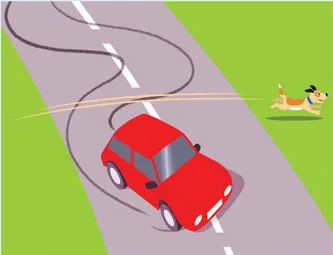A. Particular types of movement
Move is the basic verb for all movement, but don’t forget it also means ‘to move to a new house/flat’, e.g. We’ve moved. Do you want our new address?
Cars, lorries, etc. travel/drive along roads.
Trains travel along rails.
Boats/ships sail on rivers / across the sea.
Rivers/streams flow/run through towns/villages.
Things often have particular verbs associated with their types of movement. You should learn these as typical collocations when you meet them, and record them with a phrase or sentence, for example:

- The car swerved to avoid a dog which had run into the road. [moved suddenly to the side]
- White clouds drifted across the sky. [moved slowly]
- The flag fluttered in the wind. [moved gently from side to side]
- The leaves stirred in the light breeze. [moved slightly]
- The trees swayed back and forth as the wind grew stronger. [moved slowly from side to side]
B. Verbs to describe fast and slow movement
- The traffic was crawling along because of the roadworks. [moving very slowly]
- Stop dawdling! We’ll be late! [moving more slowly than is necessary]
- Suddenly a car came round the bend and tore along the road at high speed.
- Seconds later, a police car shot past after it.
- Everyone was hurrying/rushing to get their shopping done before closing time.
- The train was just creeping along at about 20 miles per hour. I knew we’d be late. [moving very slowly]
- The donkey was plodding along the road. [plodding suggests heavy, often tired, movement]
- The plane was cruising at a height of 30,000 metres. [travelling at a steady speed]
C. Nouns to describe speed and their typical contexts
- Speed is a general word used for vehicles, developments, changes, etc., e.g. We were travelling at high speed.
- Rate is often used in statistical contexts; the rate of increase/decrease, e.g. The birth rate is going down.
- Pace shows how you experience something as happening fast or slow, e.g. The lesson was going at a very slow pace.
- Velocity is used in technical/scientific contexts, e.g. The velocity of a moving object.
Common mistakes
We say at a speed/rate/pace. (NOT in or with a speed/rate/pace)
- The train was travelling at a speed of 120 kph.
(NOT The train was travelling with a speed of 120 kph.)
|


Bình luận